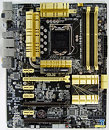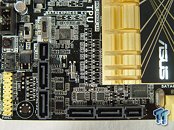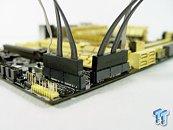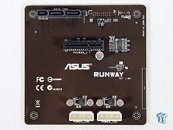- Joined
- Oct 9, 2007
- Messages
- 47,638 (7.44/day)
- Location
- Dublin, Ireland
| System Name | RBMK-1000 |
|---|---|
| Processor | AMD Ryzen 7 5700G |
| Motherboard | Gigabyte B550 AORUS Elite V2 |
| Cooling | DeepCool Gammax L240 V2 |
| Memory | 2x 16GB DDR4-3200 |
| Video Card(s) | Galax RTX 4070 Ti EX |
| Storage | Samsung 990 1TB |
| Display(s) | BenQ 1440p 60 Hz 27-inch |
| Case | Corsair Carbide 100R |
| Audio Device(s) | ASUS SupremeFX S1220A |
| Power Supply | Cooler Master MWE Gold 650W |
| Mouse | ASUS ROG Strix Impact |
| Keyboard | Gamdias Hermes E2 |
| Software | Windows 11 Pro |
ASUS released a prototype of the first desktop PC motherboard with SATA-Express support, the Z87-Deluxe/SATA-Express. A variant of ASUS' flagship socket LGA1150 motherboard from its mainline Z87 series, the Z87-Deluxe, the board features two SATA-Express ports. SATA-Express sees a fusion between two of the most successful serial I/O interfaces, SATA and PCI-Express. It's essentially ATA over PCI-Express 2.0 x2, which offers a raw bandwidth of 8 Gbps per direction, 16 Gbps total. The SATA-Express port is structured similar to the classic SATA port, with PCI-Express lanes running over two 7-pin SATA connectors, and an additional block of 4 pins that make up the 18 pins required by 2-lane PCI-Express. A SATA-Express connector is thus unified, and legacy SATA devices should still be able to run off one of the two 7-in SATA connectors in a SATA-Express block.
Since there are no SATA-Express drives in the market, ASUS gave TweakTown a MacGyver contraption that adapts SATA-Express to a physical PCI-Express 2.0 x4 slot (electrical x2). An ASUS RAIDR Express PCI-Express SSD was found to offer sequential transfer rates of around 750 MB/s on ATTO. The rest of the board is practically identical to the Z87-Deluxe. The board uses a 16-phase VRM to condition power for the LGA1150 CPU. It draws power from a combination of 24-pin ATX and 8-pin EPS connectors. Expansion slots include three PCI-Express 3.0 x16 (x16/NC/NC or x8/x8/NC or x8/x4/x4, depending on how they're populated); and four PCI-Express 2.0 x1 slots.




The Z87 Express PCH gives out six SATA 6 Gb/s ports, of which two are given away to the two SATA-Express ports (should you decide to plug-in a normal SATA drive into them), while four are given out in ordinary stacks of two ports each. The board offers a total of eight USB 3.0 ports, six on the rear panel, two by headers. Connectivity includes two gigabit Ethernet ports, 802.11 ac Wi-Fi, and Bluetooth 4.0. Display connectivity includes a DisplayPort 1.2 connector, and HDMI 1.4a. 8-channel HD audio with optical (TOSLINK) digital output, and a number of USB 2.0/1.1 ports make for the rest of the connectivity. ASUS didn't reveal availability details. For more benchmark results of the RAIDR Express on this board, click on the source link.
View at TechPowerUp Main Site
Since there are no SATA-Express drives in the market, ASUS gave TweakTown a MacGyver contraption that adapts SATA-Express to a physical PCI-Express 2.0 x4 slot (electrical x2). An ASUS RAIDR Express PCI-Express SSD was found to offer sequential transfer rates of around 750 MB/s on ATTO. The rest of the board is practically identical to the Z87-Deluxe. The board uses a 16-phase VRM to condition power for the LGA1150 CPU. It draws power from a combination of 24-pin ATX and 8-pin EPS connectors. Expansion slots include three PCI-Express 3.0 x16 (x16/NC/NC or x8/x8/NC or x8/x4/x4, depending on how they're populated); and four PCI-Express 2.0 x1 slots.




The Z87 Express PCH gives out six SATA 6 Gb/s ports, of which two are given away to the two SATA-Express ports (should you decide to plug-in a normal SATA drive into them), while four are given out in ordinary stacks of two ports each. The board offers a total of eight USB 3.0 ports, six on the rear panel, two by headers. Connectivity includes two gigabit Ethernet ports, 802.11 ac Wi-Fi, and Bluetooth 4.0. Display connectivity includes a DisplayPort 1.2 connector, and HDMI 1.4a. 8-channel HD audio with optical (TOSLINK) digital output, and a number of USB 2.0/1.1 ports make for the rest of the connectivity. ASUS didn't reveal availability details. For more benchmark results of the RAIDR Express on this board, click on the source link.
View at TechPowerUp Main Site






